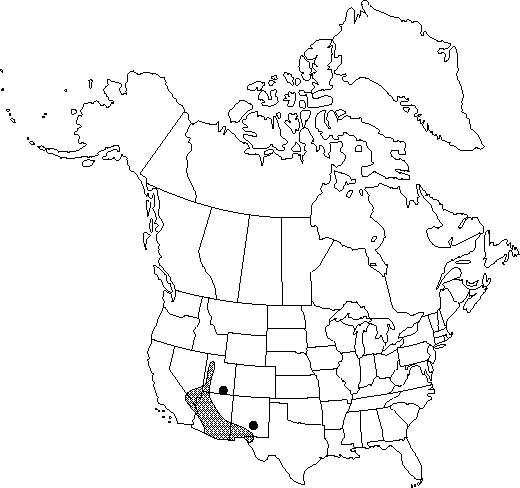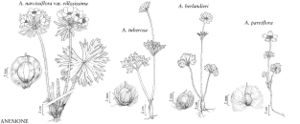Anemone tuberosa
Bull. Torrey Bot. Club 29: 151. 1902.
Aerial shoots 10-30 (-40) cm, from caudexlike tubers, tubers ascending to vertical. Basal leaves 1-3 (-5), 1-2-ternate; petiole 5-7 cm; terminal leaflet sessile, rarely petiolulate, irregularly oblanceolate, (1.5-) 2-3 (-3.5) × 1-2 (-2.5) cm, base narrowly cuneate, margins incised to dissected on distal 2/3, apex broadly acute, surfaces nearly glabrous; lateral leaflets 1-2×-parted and/or lobed; ultimate lobes 4-8 (-12) mm wide. Inflorescences 2-3 (-5) -flowered cymes or flowers solitary; peduncle proximally nearly glabrous, distally villous; involucral-bracts primarily 3, (1-) 2-tiered, simple, ±similar to basal leaves, pinnatifid, 1.5-5.5 cm (primary involucral-bracts 2-5.5 cm, secondary involucral-bracts 1.5-3.5 cm), bases distinct, broadly to narrowly cuneate to clasping, margins irregularly serrulate and pinnatifid on ca. distal 1/2, apex narrowly acute to acuminate, surfaces thinly pilose; segments primarily 3, linear to pinnatifid; lateral segments 1-2×-parted and/or lobed; ultimate lobes 1.5-2.5 mm wide. Flowers: sepals 8-10, pink to white, linear-oblong, 10-14 (-20) × (2-) 3-5 (-6) mm, sparsely hairy; stamens 50-60. Heads of achenes fusiform; pedicel (5-) 7-15 (-22) cm. Achenes: body orbiculate, flat, 2.5-3.5 × 2-2.5 mm, not winged, densely villous; beak straight, ca. 1.5 mm, minutely puberulous, not plumose. 2n=16.
Phenology: Flowering spring (Apr–May).
Habitat: Rocky slopes, streamsides
Elevation: 800-2500 m
Distribution

Ariz., Calif., Nev., N.Mex., Tex., Utah, n Mexico
Discussion
The tuberous anemones in North America (A. tuberosa, A. edwardsiana, A. okennonii, A. berlandieri, and A. caroliniana) are closely related to each other and to the South American species A. decapetala Arduino, A. triternata Vahl, A. cicutifolia I.M. Johnston, and A. sphenophylla Poeppig. Particularly useful characters in identifying North American plants are number of tiers of involucral bracts, presence or absence of heterophylly between basal leaves and involucral bracts, and presence or absence of rhizomes. The current treatment of this group primarily follows C. S. Keener and B. E. Dutton (1994), who included a discussion of the relationships among its members. For a cytotaxonomic discussion of most members of this group, see C. Joseph and M. Heimburger (1966).
Selected References
None.
Lower Taxa
"villous" is not a number.
